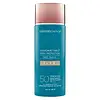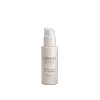Colorescience Sunforgettable Total Protection Face Shield Flex SPF 50 Versus Lumene Instant Glow UV Primer SPF 30
What's inside
What's inside
 Key Ingredients
Key Ingredients

 Benefits
Benefits

 Concerns
Concerns

 Ingredients Side-by-side
Ingredients Side-by-side

Zinc Oxide 12%
Cosmetic ColorantWater
Skin ConditioningC12-15 Alkyl Benzoate
AntimicrobialButyloctyl Salicylate
Skin ConditioningLauryl PEG-8 Dimethicone
Isododecane
EmollientPropanediol
SolventCaprylyl Methicone
Skin ConditioningDimethicone
EmollientNiacinamide
SmoothingTridecyl Salicylate
Skin ConditioningDimethicone/Vinyl Dimethicone Crosspolymer
Skin ConditioningTrilaureth-4 Phosphate
EmulsifyingDimethiconol
EmollientLauryl PEG-10 Tris(Trimethylsiloxy)Silylethyl Dimethicone
EmulsifyingMica
Cosmetic ColorantPolyester-1
Maltodextrin
AbsorbentSodium Chloride
MaskingBisabolol
MaskingDisodium Lauriminodipropionate Tocopheryl Phosphates
CleansingEthylhexylglycerin
Skin ConditioningTremella Fuciformis Sporocarp Extract
AntioxidantAllantoin
Skin ConditioningSilica Dimethyl Silylate
EmollientCaprylyl Glycol
EmollientIsoceteth-10
EmulsifyingZein
Skin ConditioningHexylene Glycol
EmulsifyingDimethylmethoxy Chromanol
AntioxidantSynthetic Fluorphlogopite
Zea Mays Starch
AbsorbentSilica
AbrasiveCaesalpinia Spinosa Fruit Pod Extract
Hydrogenated Lecithin
EmulsifyingTetrasodium Glutamate Diacetate
Caprylic/Capric Triglyceride
MaskingHelianthus Annuus Sprout Extract
Skin ConditioningPhenoxyethanol
PreservativeSodium Benzoate
MaskingBenzoic Acid
MaskingDehydroacetic Acid
PreservativeSodium Hydroxide
BufferingSodium Myristoyl Glutamate
CleansingAluminum Hydroxide
EmollientCI 77891
Cosmetic ColorantIron Oxides
Zinc Oxide 12%, Water, C12-15 Alkyl Benzoate, Butyloctyl Salicylate, Lauryl PEG-8 Dimethicone, Isododecane, Propanediol, Caprylyl Methicone, Dimethicone, Niacinamide, Tridecyl Salicylate, Dimethicone/Vinyl Dimethicone Crosspolymer, Trilaureth-4 Phosphate, Dimethiconol, Lauryl PEG-10 Tris(Trimethylsiloxy)Silylethyl Dimethicone, Mica, Polyester-1, Maltodextrin, Sodium Chloride, Bisabolol, Disodium Lauriminodipropionate Tocopheryl Phosphates, Ethylhexylglycerin, Tremella Fuciformis Sporocarp Extract, Allantoin, Silica Dimethyl Silylate, Caprylyl Glycol, Isoceteth-10, Zein, Hexylene Glycol, Dimethylmethoxy Chromanol, Synthetic Fluorphlogopite, Zea Mays Starch, Silica, Caesalpinia Spinosa Fruit Pod Extract, Hydrogenated Lecithin, Tetrasodium Glutamate Diacetate, Caprylic/Capric Triglyceride, Helianthus Annuus Sprout Extract, Phenoxyethanol, Sodium Benzoate, Benzoic Acid, Dehydroacetic Acid, Sodium Hydroxide, Sodium Myristoyl Glutamate, Aluminum Hydroxide, CI 77891, Iron Oxides
Water
Skin ConditioningPhenoxyethyl Caprylate
Butylene Glycol
HumectantDiethylamino Hydroxybenzoyl Hexyl Benzoate
UV FilterEthyl Oleate
EmollientEthylhexyl Triazone
UV AbsorberPhenylbenzimidazole Sulfonic Acid
UV AbsorberRubus Chamaemorus Fruit Juice Extract
HumectantCanola Oil
EmollientTromethamine
BufferingSodium Stearoyl Glutamate
CleansingEpilobium Angustifolium Extract
Skin ConditioningRubus Chamaemorus Seed Extract
Skin ConditioningPhenoxyethanol
PreservativeCetearyl Alcohol
EmollientCetyl Palmitate
EmollientHydroxyethyl Acrylate/Sodium Acryloyldimethyl Taurate Copolymer
Emulsion StabilisingHydroxyacetophenone
AntioxidantPropanediol
SolventSilica
AbrasiveTocopheryl Acetate
AntioxidantMica
Cosmetic ColorantXanthan Gum
EmulsifyingGlycerin
HumectantEthylhexylglycerin
Skin ConditioningPolysorbate 60
EmulsifyingSorbitan Isostearate
EmulsifyingPhenethyl Alcohol
MaskingSodium Carrageenan
Emulsion StabilisingAluminum Hydroxide
EmollientAlgin
MaskingMaris Sal
Skin ConditioningSodium Hydroxide
BufferingSodium Benzoate
MaskingPotassium Sorbate
PreservativeCitric Acid
BufferingLinalool
PerfumingCitronellol
PerfumingParfum
MaskingCI 77491
Cosmetic ColorantCI 77492
Cosmetic ColorantCI 77891
Cosmetic ColorantWater, Phenoxyethyl Caprylate, Butylene Glycol, Diethylamino Hydroxybenzoyl Hexyl Benzoate, Ethyl Oleate, Ethylhexyl Triazone, Phenylbenzimidazole Sulfonic Acid, Rubus Chamaemorus Fruit Juice Extract, Canola Oil, Tromethamine, Sodium Stearoyl Glutamate, Epilobium Angustifolium Extract, Rubus Chamaemorus Seed Extract, Phenoxyethanol, Cetearyl Alcohol, Cetyl Palmitate, Hydroxyethyl Acrylate/Sodium Acryloyldimethyl Taurate Copolymer, Hydroxyacetophenone, Propanediol, Silica, Tocopheryl Acetate, Mica, Xanthan Gum, Glycerin, Ethylhexylglycerin, Polysorbate 60, Sorbitan Isostearate, Phenethyl Alcohol, Sodium Carrageenan, Aluminum Hydroxide, Algin, Maris Sal, Sodium Hydroxide, Sodium Benzoate, Potassium Sorbate, Citric Acid, Linalool, Citronellol, Parfum, CI 77491, CI 77492, CI 77891
 Reviews
Reviews

Ingredients Explained
These ingredients are found in both products.
Ingredients higher up in an ingredient list are typically present in a larger amount.
Aluminum Hydroxide is a form of aluminum. It can be naturally found in nature as the mineral gibbsite. In cosmetics, Aluminum Hydroxide is used as a colorant, pH adjuster, and absorbent.
As a colorant, Aluminum Hydroxide may add opacity, or reduce the transparency. Aluminum hydroxide is contains both basic and acidic properties.
According to manufacturers, this ingredient is an emollient and humectant. This means it helps hydrate the skin.
In medicine, this ingredient is used to help relieve heartburn and help heal ulcers.
There is currently no credible scientific evidence linking aluminum hydroxide in cosmetics to increased cancer risk.
Major health organizations allow the use of aluminum hydroxide in personal care products and have not flagged it as a carcinogenic risk at typical usage levels.
Learn more about Aluminum HydroxideCi 77891 is a white pigment from Titanium dioxide. It is naturally found in minerals such as rutile and ilmenite.
It's main function is to add a white color to cosmetics. It can also be mixed with other colors to create different shades.
Ci 77891 is commonly found in sunscreens due to its ability to block UV rays.
Learn more about CI 77891Ethylhexylglycerin (we can't pronounce this either) is commonly used as a preservative and skin softener. It is derived from glyceryl.
You might see Ethylhexylglycerin often paired with other preservatives such as phenoxyethanol. Ethylhexylglycerin has been found to increase the effectiveness of these other preservatives.
Mica is a naturally occurring mineral used to add shimmer and color in cosmetics. It can also help improve the texture of a product or give it an opaque, white/silver color.
Serecite is the name for very fine but ragged grains of mica.
This ingredient is often coated with metal oxides like titanium dioxide. Trace amounts of heavy metals may be found in mica, but these metals are not harmful in our personal products.
Mica has been used since prehistoric times throughout the world. Ancient Egyptian, Indian, Greek, Roman, Aztec, and Chinese civilizations have used mica.
Learn more about MicaPhenoxyethanol is a preservative that has germicide, antimicrobial, and aromatic properties. Studies show that phenoxyethanol can prevent microbial growth. By itself, it has a scent that is similar to that of a rose.
It's often used in formulations along with Caprylyl Glycol to preserve the shelf life of products.
Propanediol is an all-star ingredient. It softens, hydrates, and smooths the skin.
It’s often used to:
Propanediol is not likely to cause sensitivity and considered safe to use. It is derived from corn or petroleum with a clear color and no scent.
Learn more about PropanediolSilica, also known as silicon dioxide, is a naturally occurring mineral. It is used as a fine, spherical, and porous powder in cosmetics.
Though it has exfoliant properties, the function of silica varies depending on the product.
The unique structure of silica enhances the spreadability and adds smoothness, making it a great texture enhancer.
It is also used as an active carrier, emulsifier, and mattifier due to its ability to absorb excess oil.
In some products, tiny microneedles called spicules are made from silica or hydrolyzed sponge. When you rub them in, they lightly polish away dead skin layers and enhance the penetration of active ingredients.
Learn more about SilicaSodium Benzoate is a preservative. It's used in both cosmetic and food products to inhibit the growth of mold and bacteria. It is typically produced synthetically.
Both the US FDA and EU Health Committee have approved the use of sodium benzoate. In the US, levels of 0.1% (of the total product) are allowed.
Sodium benzoate works as a preservative by inhibiting the growth of bacteria inside of cells. It prevents the cell from fermenting a type of sugar using an enzyme called phosphofructokinase.
It is the salt of benzoic acid. Foods containing sodium benzoate include soda, salad dressings, condiments, fruit juices, wines, and snack foods.
Studies for using ascorbic acid and sodium benzoate in cosmetics are lacking, especially in skincare routines with multiple steps.
We always recommend speaking with a professional, such as a dermatologist, if you have any concerns.
Learn more about Sodium BenzoateSodium Hydroxide is also known as lye or caustic soda. It is used to adjust the pH of products; many ingredients require a specific pH to be effective.
In small amounts, sodium hydroxide is considered safe to use. However, large amounts may cause chemical burns due to its high alkaline.
Your skin has a natural pH and acid mantle. This acid mantle helps prevent harmful bacteria from breaking through. The acid mantle also helps keep your skin hydrated.
"Alkaline" refers to a high pH level. A low pH level would be considered acidic.
Learn more about Sodium HydroxideWater. It's the most common cosmetic ingredient of all. You'll usually see it at the top of ingredient lists, meaning that it makes up the largest part of the product.
So why is it so popular? Water most often acts as a solvent - this means that it helps dissolve other ingredients into the formulation.
You'll also recognize water as that liquid we all need to stay alive. If you see this, drink a glass of water. Stay hydrated!
Learn more about Water